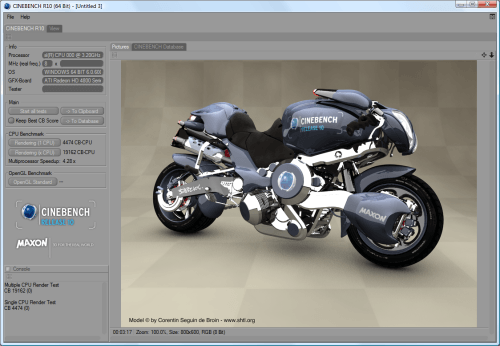- Qualcomm Launches Snapdragon 4 Gen 2 Mobile Platform
- AMD Launches Ryzen PRO 7000 Series Mobile & Desktop Platform
- Intel Launches Sleek Single-Slot Arc Pro A60 Workstation Graphics Card
- NVIDIA Announces Latest Ada Lovelace Additions: GeForce RTX 4060 Ti & RTX 4060
- Maxon Redshift With AMD Radeon GPU Rendering Support Now Available
Intel’s Sandy Bridge Revealed: Core i5-2500K & i7-2600K Reviewed

The long-awaited launch of Intel’s Sandy Bridge is here, and we have all of the details of what to expect, what you need to “upgrade”, what models will be available at launch, and of course, their prices. We’re taking a look at two of the higest-end offerings, the Core i5-2500K and i7-2600K – both quad-cores and both fully unlocked.
Page 6 – Workstation: Autodesk 3ds Max, Cinebench, POV-Ray
Autodesk’s 3ds Max is without question an industry standard when it comes to 3D modeling and animation, with DreamWorks, BioWare and Blizzard Entertainment being a few of its notable users. It’s a multi-threaded application that’s designed to be right at home on multi-core and multi-processor workstations or render farms, so it easily tasks even the biggest system we can currently throw at it.
For our testing, we use two project files that are designed to last long enough to find any weakness in our setup and also allows us to find a result that’s easily comparable between both motherboards and processors. The first project is a dog model included on recent 3ds Max DVD’s, which we infused with some Techgage flavor.
Our second project is a Bathroom scene that makes heavy use of ray tracing. Like the dog model, this one is also included with the application’s sample files DVD. The dog is rendered at an 1100×825 resolution, while the Bathroom is rendered as 1080p (1920×1080).

So far, things are off to a great start! The Core i7-2600K, a $317 offering, slots right behind the $999 Core i7-980X Extreme Edition six-core… that’s impressive. It also proves faster than the Core i7-975 Extreme Edition quad-core – another good sign.
The $216 Core i5-2500K, which lacks HyperThreading, is noticeably slower than the Core i7-2600K, but it still manages to surpass most of the models tested here.
Cinebench R10
Like 3DS Max, Cinema 4D is another popular cross-platform 3D graphics application that’s used by new users and experts alike. Its creators, Maxon, are well aware that their users are interested in huge computers to speed up rendering times, which is one reason why they released Cinebench to the public.
Cinebench R10 is based on the Cinema 4D engine and the test consists of rendering a high-resolution model of a motorcycle and gives a score at the end. Like most other 3D applications on the market, Cinebench will take advantage of as many cores as you can throw at it.

The Sandy Bridge models continue to impress here, out-pacing everything except for the high-end Extreme Edition six-core. Even the single-threaded performance of the Core i5-2500K manages to beat the faster single-thread clock speed of the Core i7-980X. Need proof that Sandy Bridge is an efficient architecture? There it is.
Support our efforts! With ad revenue at an all-time low for written websites, we're relying more than ever on reader support to help us continue putting so much effort into this type of content. You can support us by becoming a Patron, or by using our Amazon shopping affiliate links listed through our articles. Thanks for your support!







